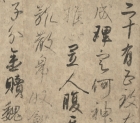Japanese Gallery (Honkan) Room T1
May 22, 2012 (Tue) - June 24, 2012 (Sun)
Since ancient times, calligraphic writings have repeatedly been transcribed. There are various reasons for this, including to spread scriptures, literature and other written texts, to practice calligraphy, and to protect cultural properties. A main activity of calligraphy is transcription. Through transcribing, calligraphers can closely engage with a work of calligraphy, imprinting it in their memories. Transcription of calligraphy has also allowed new forms of creativity.
There are several methods of transcribing calligraphy, such as copying through close imitation, tracing outlines of characters and filling in the spaces (a method called soko tenboku), as well as taking rubbings. Calligraphy created in these ways was widely popularized in the Edo period (1603-1868) through printed books. In many cases of transcribed calligraphy, the original pieces have been lost, making the transcriptions extremely precious. This exhibition introduces calligraphy transcribed in various ways, with examples taken from ancient times to the modern era. We invite visitors to view the vestiges of people who have engaged with calligraphy.

